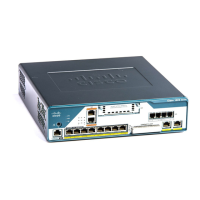How to Configure ACR and DCR
Configuring ACR for T1/E1
Configuring Adaptive Clock Recovery of T1/E1 Interfaces for SAToP
Before You Begin
Before configuring Adaptive Clock Recovery, CEM must be configured. Below are the guidelines to configure
clock recovery:
• The node (chassis) on which the DS1 is configured for ACR, must have its own clock derived from
BITS/GPS/Stratum clock.
• The minimum packet size of CEM pseudowires on the network that delivers robust clock recovery is 64
bytes.
To configure the clock on T1/E1 interfaces for SAToP in controller mode, use the following commands:
enable
configure terminal
controller t1 0/0/1
clock source recovered 1
cem-group 0 unframed
exit
To configure the clock recovery on T1/E1 interfaces in global configuration mode, use the following commands:
recovered-clock 0 0
clock recovered 1 adaptive cem 1 0
exit
The clock configuration on controller must be done before configuring the clock recovery on global
configuration mode.
Note
To remove the clock configuration in ACR and DCR, you must remove the recovery clock configuration in
global configuration mode and then remove the controller configuration.
Verifying the Adaptive Clock Recovery Configuration of T1/E1 Interfaces for SAToP
Use the show recovered-clock command to verify the adaptive clock recovery of T1/E1 interfaces for SAToP:
Router# show recovered-clock
Recovered clock status for subslot 0/4
--------------------------------------
Clock Type Mode CEM Status Frequency Offset(ppb) Circuit-No
0 DS1 ADAPTIVE 0 ACQUIRED n/a 0 (Port)
48-Port T1/E1 CEM Interface Module Configuration Guide, Cisco IOS XE Fuji 16.7.x (Cisco NCS 4200 Series)
42
Clock Recovery System for CESoPSN
How to Configure ACR and DCR

